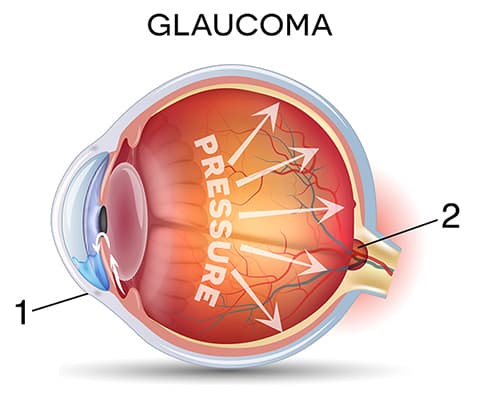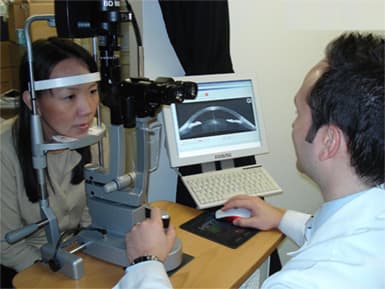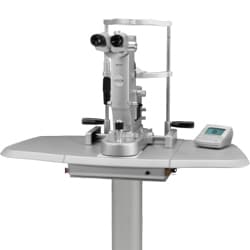Glaucoma

Glaucoma is one of the leading causes of blindness worldwide. It is often known as the “silent thief of sight” because it causes irreversible damage before one even experiences any symptoms. It is a disease that causes irreversible damage to the optic nerve, the connection between the eyes and the brain. The optic nerve transfers images we see to the brain to be interpreted. Once the optic nerve is damaged, the delivery route for the images becomes blocked, preventing the brain from receiving any signals from the eye. If the brain no longer receives these messages, we don’t see!
Damage to the optic nerve thus results in irreversible vision loss. Our vision is one of the most important aspects of our lives and glaucoma puts it at risk. The timely and correct treatment of glaucoma can prevent blindness. At Hudson Valley Eye Surgeons, our glaucoma eye specialist is an authority in glaucoma diagnosis, treatment, and prevention, helping patients proactively manage glaucoma and ensure that they maintain as much vision as possible.
What Is Glaucoma?
Glaucoma refers to a group of related disorders that can damage the optic nerve. This causes you to have a loss of peripheral vision to the point in which you can go blind. Although the exact cause is unknown, glaucoma is typically associated with high intraocular pressure (IOP); ‘the pressure inside of the eye’. According to the National Eye Institute, approximately 2.2 million Americans suffer from glaucoma. The condition is a leading cause of blindness in older adults.

What are types of Glaucoma?
There are four types of glaucoma, each contributing to a different cause of fluid build-up in the eye. The two major types of glaucoma are primary open-angle glaucoma (POAG) and closed-angle glaucoma, also known as angle-closure glaucoma.
Primary open-angle glaucoma (POAG)
Primary open-angle glaucoma (POAG) is the most common form of glaucoma and develops slowly over a number of years. The drainage system in the eye becomes impaired causing an elevation in eye pressure, permanently damaging the optic nerve. There are usually no symptoms of this form of glaucoma.
Angle-closure glaucoma is less common than POAG. In angle-closure glaucoma, IOP can increase slowly or rapidly because of the narrowing of the drainage system in the eye or due to a complete mechanical blockage of fluid outflow. Once the drainage system becomes blocked, pressure builds rapidly, causing eye pain, blurred vision, halos around lights, headache, and nausea. This type of glaucoma is more common in patients who are farsighted or those who have a narrow drainage system.
Normal-Tension Glaucoma
Normal-Tension Glaucoma is the type of glaucoma-related to normal eye pressure resulting from vascular dysregulation (poor blood flow) to the optic nerve. Improper blood flow causes progressive optic nerve damage because of neuronal cell death.
Secondary glaucoma results from a preexisting health condition, like high blood pressure or diabetes, trauma or medications like steroids.
What are Glaucoma Symptoms?
Glaucoma usually has few or no symptoms. Many people do not realize they have glaucoma until they start noticing vision loss. At that point, any vision loss cannot be repaired. The optic nerve is like an electrical cable with millions of ‘wires’. When there is damage to small portions of the wires, then you can develop blind spots. However, most patients do not notice these blind spots until there is significant damage to the optic nerve. This is why we encourage routine eye examinations. Yearly glaucoma tests can help prevent glaucoma-related vision loss.
An acute closed-angle glaucoma attack is different. Because of the sudden increase in IOP, closed-angle glaucoma can cause significant symptoms. An acute closed-angle glaucoma attack is considered a medical emergency.
If you experience any of the following symptoms, be sure to contact our office or go to your local emergency room:
- Severe eye pain
- Nausea
- Vomiting
- Headache
- Blurry vision
- Halos around lights
Diagnosis

During a comprehensive eye exam, your doctor will use a number of methods to detect glaucoma. Applanation tonometry is often used to measure IOP and gonioscopy is performed to assess the drainage system in your eye. Your eyes will be dilated, allowing your doctor to check for signs of optic nerve damage, and a visual acuity test can screen for any changes to your vision. Optic nerve photos, pachymetry (a measurement of corneal thickness) and a visual field test will be performed to assess for any sign of glaucoma. Early diagnosis and intervention are the best way to ensure the success of your treatment.
Causes
In a healthy, functioning eye, canals drain a fluid called aqueous humor from inside the anterior chamber of the eye, allowing IOP to remain normal. Glaucoma develops when these canals cannot drain properly, resulting in an increase in eye pressure. Although not everyone with elevated IOP develops the disease, it is a risk factor for glaucoma and should be monitored closely.
What are Risk Factors of Glaucoma?
Glaucoma can happen to anyone, but there are some risk factors that can make glaucoma more likely to occur.
Common glaucoma risk factors include:
- Age. Older people are more likely to develop glaucoma. However, it is still possible for young people to get glaucoma and it can even be present at birth (congenital glaucoma).
- Ocular Hypertension. Ocular hypertension (high eye pressure) is a common cause of glaucoma and should be monitored closely.
- African American Background. People of African American descent are more likely to develop glaucoma and the risk of developing glaucoma can occur at a younger age than that of other groups.
- Family history. There is some evidence that genetics and family history play a part in glaucoma development. If your family has a history of glaucoma, you should come in for yearly eye exams to be on the safe side as you have a greater risk of developing it.
- Diabetes. Diabetic patients are more susceptible to developing glaucoma, especially those with uncontrolled blood sugar levels.
- Other eye conditions. Severe eye injuries can cause increased eye pressure. Other eye conditions that could cause an increased risk of glaucoma include eye tumors, retinal detachment, eye inflammation, and lens dislocation.
Glaucoma Treatment
Treatment Options

The goal of glaucoma treatment is to lower and stabilize eye pressure to prevent vision loss. Regardless of treatment, catching glaucoma early is the best way to prevent glaucoma-related vision loss. Be sure to have routine eye examinations, especially if you have glaucoma risk factors.
Glaucoma treatment is recommended based on the type of glaucoma the patient is experiencing and its severity. POAG can be treated with eye drops. In the case that eye pressure needs to be relieved more quickly (to treat closed-angle glaucoma, for example), laser surgery may be recommended to manually open the drainage canals. For more severe or aggressive cases of glaucoma that have not responded to other treatments, your surgeon can create a tiny flap on the surface of the eye, allowing fluid to be drained, lowering IOP. Another surgical option involves placing a valve in the eye, allowing fluid to drain.
Common glaucoma treatment methods include:
- Eye drops. Medicated eye drops are commonly used to keep eye pressure stable. Eye drops are typically used on patients with primary open-angle glaucoma.
- Oral medications. Like eye drops, oral medication offers a non-invasive method of lowering and stabilizing IOP.
- Selective laser trabeculoplasty. This laser surgery procedure allows your doctor to increase the outflow of fluid by creating tiny filtration holes in the drainage system of the eye. This procedure is performed in the office as an outpatient procedure.
- Iridotomy. An iridotomy uses a laser to create a hole in the iris for fluid to drain out of, improving outflow.
- Trabeculectomy. This procedure involves removing part of the eye’s drainage system.
- Minimally invasive glaucoma surgery (MIGS). The MIGS group of operations have been developed in recent years to reduce some of the complications of most standard glaucoma surgeries. MIGS procedures work by using microscopic-sized equipment and tiny incisions. While they reduce the incidence of complications, some degree of effectiveness is also traded for increased safety.
The goal of all glaucoma surgery is to lower eye pressure to prevent or reduce damage to the optic nerve. It is not uncommon for your doctor to devise a treatment plan that includes more than one treatment method. You may receive surgery as your primary treatment method and then use eye drops or medications to supplement the results.
Treatment Results
Vision loss from glaucoma cannot be reversed, however appropriate treatment can slow the effects of the disease and help protect your remaining eyesight. The results of your treatment will depend on how early intervention was initiated, as well as the progression of the disease. Our goal is to protect and preserve your eyesight and choosing an experienced eye doctor is the most important decision you can make to ensure the success of your treatment. Visit our main offices in Fishkill, NY today!
Please call us today at 845-896-9280 to schedule a comprehensive eye exam with one of our experienced doctors.

